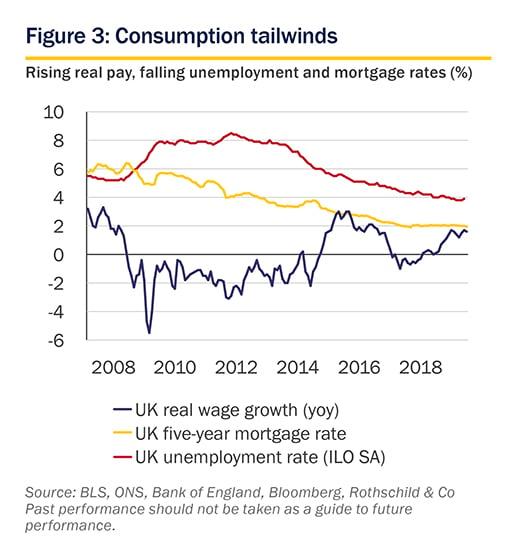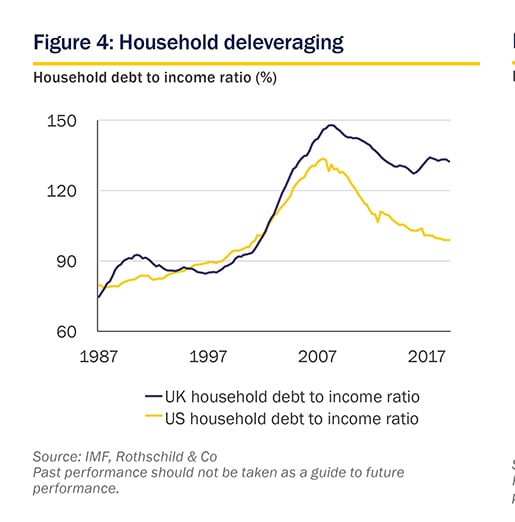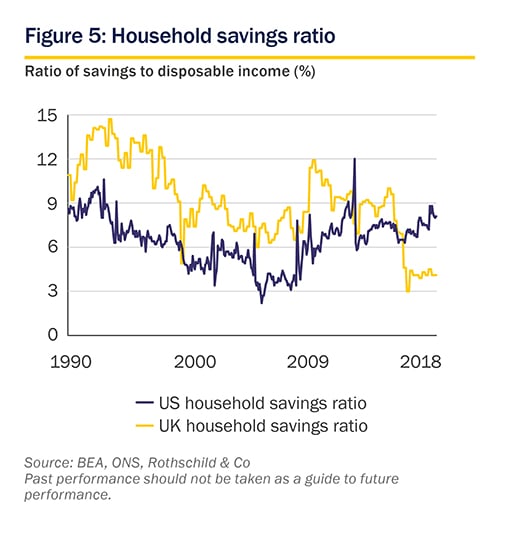Market Perspective – UK consumers: ready for Brexit?

Kevin Gardiner, Global Investment Strategist, Wealth Management
Momentum, but less wiggle room
The UK is still mired in Brexit stalemate. Global investors have not needed to own many UK stocks - which have unsurprisingly underperformed for many years, not just because of Brexit. But amid the confusion and hyperbole, what can we usefully advise local investors?
There must now be a lot of bad news priced in, and anything other than a sudden no-deal outcome might result in a stronger pound and a rebound in the domestically oriented indices (such as the FTSE 250). Gilts might fall back as their safe-haven allure fades. The headline stock indices such as the FTSE 100 are not really sterling assets as most of their earnings are generated outside the UK. They have also been underperforming in common currency terms, but this has had a lot to do with their idiosyncratic sector mix (no tech but lots of oil, mining, Asia-facing banks and big pharma), which will remain intact. And most UK-based portfolios should have a healthy holding of global indices alongside the large-cap UK names.
A no-deal outcome would likely result in short-term disruption, but even the BoE is beginning to see that the risk cannot be quantified. We still hope not to find out, but think the lasting impact would be manageable. As we have noted often, the UK is one of the most competitive European economies, and not just because of that lower exchange rate. The government (we use the term loosely) also has plenty of room to boost its own spending, and plans to do just that.
Click the image to enlarge
Meanwhile, UK consumer demand looks to us to be potentially resilient. Consumer spending is determined by incomes, balance sheets and confidence (the latter determines just how much of their income or balance sheet they are willing to flex).
Household income - shaped by wages, jobs, benefits, taxes and mortgage payments - is perhaps the most significant factor, and for now at least, has some momentum. Jobs growth has been strong, and with the unemployment rate at its lowest since 1974 - which also supports confidence - inflation-adjusted pay growth is now positive again. Mortgage rates recently fell to new lows, and the BoE will not raise rates while Brexit is unclear.
Balance sheets too may be less vulnerable than feared. After the excesses of the noughties, consumers have been more restrained, and there has been a significant fall in household debt as a proportion of income (although this remains elevated by long-term historical standards - and more so than in the US, where households have made a bigger adjustment).
Click the images to enlarge
Meanwhile, we have seen a sharp rise in assets. House values are nearly two-fifths above their pre-crisis peak, and household net worth is at an all-time high of five times disposable income. Again though, in the US the comparable figure is an even bigger six times.
What about confidence itself? If it takes a knock, then belt tightening might follow - even if incomes and wealth are intact. As measured by what consumers say in surveys, it can look fragile. But when judged by what consumers do, it looks stronger. Since the 2016 EU referendum, surveys have weakened, even though (as noted) unemployment has fallen. But spending has continued to grow, and - significantly - so too has the proportion of disposable incomes that are spent: the aggregate saving rate has fallen. If consumers were that worried, the savings rate would rise, not fall.
Surveys are subjective and reflect recent news. And some objective developments don't always make themselves felt immediately. For example, consumers may be concerned about the impact of Brexit on house prices, but until they are more directly impacted - perhaps when they attempt to sell their home - this may not affect spending.
Headwinds ahead
Of course, the fall in the savings ratio may have used up a potential buffer against bad news.
And if anything, the move in the saving ratio may understate UK consumers' confidence of late. If we take into account investment in housing alongside spending on consumption, UK consumer cashflow is in deficit, albeit not at the pace seen in the noughties. Again, this contrasts with the more prudent (less confident?) US consumer, who is currently a net lender and provider of liquidity, not a borrower.
For now we give the UK consumer the benefit of the doubt. The second quarter fall in GDP reflected inventories, not a weak consumer. A tight labour market, subdued inflation, low mortgage rates and an improved debt ratio are supportive of demand for the time being at least.
Click here to continue: Market Perspective: Economy and markets: background
In this Market Perspective:
- Foreword
- Bondstock
- UK consumers: ready for Brexit? (current page)
- Economy and markets: background
- Important information
Download the full Market Perspective in PDF format (PDF 704 KB)


